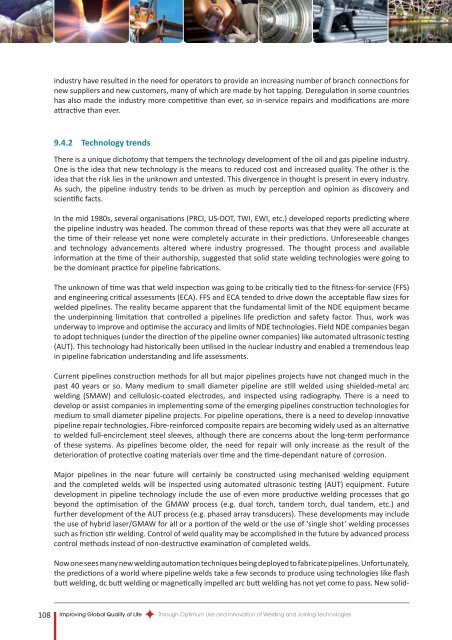Improving Global Quality of Life
Improving Global Quality of Life
Improving Global Quality of Life
Create successful ePaper yourself
Turn your PDF publications into a flip-book with our unique Google optimized e-Paper software.
industry have resulted in the need for operators to provide an increasing number <strong>of</strong> branch connections for<br />
new suppliers and new customers, many <strong>of</strong> which are made by hot tapping. Deregulation in some countries<br />
has also made the industry more competitive than ever, so in-service repairs and modifications are more<br />
attractive than ever.<br />
9.4.2 Technology trends<br />
There is a unique dichotomy that tempers the technology development <strong>of</strong> the oil and gas pipeline industry.<br />
One is the idea that new technology is the means to reduced cost and increased quality. The other is the<br />
idea that the risk lies in the unknown and untested. This divergence in thought is present in every industry.<br />
As such, the pipeline industry tends to be driven as much by perception and opinion as discovery and<br />
scientific facts.<br />
In the mid 1980s, several organisations (PRCI, US-DOT, TWI, EWI, etc.) developed reports predicting where<br />
the pipeline industry was headed. The common thread <strong>of</strong> these reports was that they were all accurate at<br />
the time <strong>of</strong> their release yet none were completely accurate in their predictions. Unforeseeable changes<br />
and technology advancements altered where industry progressed. The thought process and available<br />
information at the time <strong>of</strong> their authorship, suggested that solid state welding technologies were going to<br />
be the dominant practice for pipeline fabrications.<br />
The unknown <strong>of</strong> time was that weld inspection was going to be critically tied to the fitness-for-service (FFS)<br />
and engineering critical assessments (ECA). FFS and ECA tended to drive down the acceptable flaw sizes for<br />
welded pipelines. The reality became apparent that the fundamental limit <strong>of</strong> the NDE equipment became<br />
the underpinning limitation that controlled a pipelines life prediction and safety factor. Thus, work was<br />
underway to improve and optimise the accuracy and limits <strong>of</strong> NDE technologies. Field NDE companies began<br />
to adopt techniques (under the direction <strong>of</strong> the pipeline owner companies) like automated ultrasonic testing<br />
(AUT). This technology had historically been utilised in the nuclear industry and enabled a tremendous leap<br />
in pipeline fabrication understanding and life assessments.<br />
Current pipelines construction methods for all but major pipelines projects have not changed much in the<br />
past 40 years or so. Many medium to small diameter pipeline are still welded using shielded-metal arc<br />
welding (SMAW) and cellulosic-coated electrodes, and inspected using radiography. There is a need to<br />
develop or assist companies in implementing some <strong>of</strong> the emerging pipelines construction technologies for<br />
medium to small diameter pipeline projects. For pipeline operations, there is a need to develop innovative<br />
pipeline repair technologies. Fibre-reinforced composite repairs are becoming widely used as an alternative<br />
to welded full-encirclement steel sleeves, although there are concerns about the long-term performance<br />
<strong>of</strong> these systems. As pipelines become older, the need for repair will only increase as the result <strong>of</strong> the<br />
deterioration <strong>of</strong> protective coating materials over time and the time-dependant nature <strong>of</strong> corrosion.<br />
Major pipelines in the near future will certainly be constructed using mechanised welding equipment<br />
and the completed welds will be inspected using automated ultrasonic testing (AUT) equipment. Future<br />
development in pipeline technology include the use <strong>of</strong> even more productive welding processes that go<br />
beyond the optimisation <strong>of</strong> the GMAW process (e.g. dual torch, tandem torch, dual tandem, etc.) and<br />
further development <strong>of</strong> the AUT process (e.g. phased array transducers). These developments may include<br />
the use <strong>of</strong> hybrid laser/GMAW for all or a portion <strong>of</strong> the weld or the use <strong>of</strong> ‘single shot’ welding processes<br />
such as friction stir welding. Control <strong>of</strong> weld quality may be accomplished in the future by advanced process<br />
control methods instead <strong>of</strong> non-destructive examination <strong>of</strong> completed welds.<br />
Now one sees many new welding automation techniques being deployed to fabricate pipelines. Unfortunately,<br />
the predictions <strong>of</strong> a world where pipeline welds take a few seconds to produce using technologies like flash<br />
butt welding, dc butt welding or magnetically impelled arc butt welding has not yet come to pass. New solid-<br />
108 <strong>Improving</strong> <strong>Global</strong> <strong>Quality</strong> <strong>of</strong> <strong>Life</strong> Through Optimum Use and Innovation <strong>of</strong> Welding and Joining Technologies
















